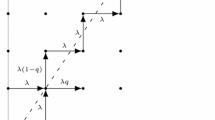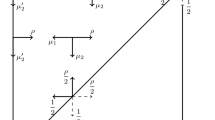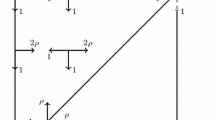Abstract
In this paper we compare the exponential symmetric shortest queue system with two related systems: the shortest queue system with Threshold Jockeying and the shortest queue system with Threshold Blocking. The latter two systems are easier to analyse and are shown to give tight lower and upper bounds respectively for the mean waiting time in the shortest queue system. The approach also gives bounds for the distribution of the total number of jobs in the system.
Similar content being viewed by others
References
I.J.B.F. Adan, J. Wessels and W.H.M. Zijm, Analysis of the symmetric shortest queue problem, Stochastic Mod. 6 (1990) 691–713.
I.J.B.F. Adan, J. Wessels and W.H.M. Zijm, Matrix-geometric analysis of the shortest queue problem with threshold jockeying, Oper. Res. Lett. 13 (1993) 107–112.
J.P.C. Blanc, The power-series algorithm applied to the shortest-queue model, Oper. Res. 40 (1992) 157–167.
J.W. Cohen and O.J. Boxma,Boundary Value Problems in Queueing System Analysis (North-Holland, Amsterdam, 1983).
B.W. Conolly, The autostrada queueing problem, J. Appl. Prob. 21 (1984) 394–403.
N.M. van Dijk and B.F. Lamond, Simple bounds for finite single-server exponential tandem queues, Oper. Res. 36 (1988) 470–477.
N.M. van Dijk and J. van der Wal, Simple bounds and monotonicity results for finite multi-server exponential tandem queues, Queueing Syst. 4 (1989) 1–16.
G. Fayolle and R. Iasnogorodski, Two coupled processors: the reduction to a Riemann-Hilbert problem, Z. Wahrsch. Verw. Gebiete (1979) 325–351.
L. Flatto and H.P. McKean, Two parallel queues with equal servicing rates, Science Report, RC5916, IBM (1977).
L. Flatto and H.P. McKean, Two queues in parallel, Comm. Pure Appl. Math. 30 (1977) 255–263.
G.J. Foschini and J. Salz, A basic dynamic routing problem and diffusion, IEEE Trans. Commun. COM-26 (1978) 320–327.
I. Gertsbakh, The shorter queue problem: A numerical study using the matrix-geometric solution, Eur. J. Oper. Res. 15 (1984) 374–381.
W.K. Grassmann, Transient and steady state results for two parallel queues, OMEGA Int. J. Manag. Sci. 8 (1980) 105–112.
W.K. Grassmann and Y. Zhao, A numerically stable algorithm for two server queue models, Queueing Syst. 8 (1991) 59–80.
F.A. Haight, Two queues in parallel, Biometrica 45 (1958) 401–410.
S. Halfin, The shortest queue problem, J. Appl. Prob. 22 (1985) 865–878.
G. Hooghiemstra, M. Keane and S. van de Ree, Power series for stationary distributions of coupled processor models, SIAM J. Appl. Math. (1988) 1159–1166.
J.F.C. Kingman, Two similar queues in parallel, Ann. Math. Statist. 32 (1961) 1314–1323.
C. Knessl, B.J. Matkowsky, Z. Schuss and C. Tier, Two parallel queues with dynamic routing, IEEE Trans. Commun. COM-34 (1986) 1170–1175.
J.C.S. Lui and R.R. Muntz, Algorithmic approach to bounding the mean response time of a minimum expected delay routing system, Perf. Eval. Rev. 20 (1992) 140–151.
R.D. Nelson and T.K. Philips, An approximation to the response time for shortest queue routing, Perf. Eval. Rev. 17 (1989) 181–189.
M.F. Neuts,Matrix-Geometric Solutions in Stochastic Models (Johns Hopkins University Press, Baltimore, 1981).
V. Ramaswami and G. Latouche, A general class of Markov processes with explicit matrixgeometric solutions, OR Spectrum 8 (1986) 209–218.
B.M. Rao and M.J.M. Posner, Algorithmic and approximation analysis of the shorter queue model, Naval Res. Log. 34 (1987) 381–398.
R. Schassberger, Ein Wartesystem mit zwei parallelen Warteschlängen, Computing 3 (1968) 110–124.
R. Schassberger, A service system with two parallel queues, Computing 4 (1969) 24–29.
J. van der Wal and P.J. Schweitzer, Iterative bounds on the equilibrium distribution of a finite Markov chain, Prob. Eng. Inf. Sci. 1 (1987) 117–131.
J. van der Wal, Monotonicity of the throughput of a closed expoential queueing network in the number of jobs, OR Spectrum 11 (1989) 97–100.
Author information
Authors and Affiliations
Rights and permissions
About this article
Cite this article
Adan, I., van Houtum, GJ. & van der Wal, J. Upper and lower bounds for the waiting time in the symmetric shortest queue system. Ann Oper Res 48, 197–217 (1994). https://doi.org/10.1007/BF02024665
Issue Date:
DOI: https://doi.org/10.1007/BF02024665




